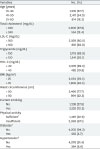2. Korean Statistical Information Service. Cause of death statistics 1983–2016. Daejeon: Korean Statistical Information Service;2017. Accessed 6 Jun 2018.
http://kosis.kr/search/search.do.
4. World Health Organization. Prevention of cardiovascular disease: guidelines for assessment and management of cardiovascular risk. Geneva: World Health Organization;2007.
5. D'Agostino RB Sr, Vasan RS, Pencina MJ, Wolf PA, Cobain M, Massaro JM, et al. General cardiovascular risk profile for use in primary care: the Framingham heart study. Circulation. 2008; 117(6):743–753.
6. Versteylen MO, Joosen IA, Shaw LJ, Narula J, Hofstra L. Comparison of Framingham, PROCAM, SCORE, and Diamond Forrester to predict coronary atherosclerosis and cardiovascular events. J Nucl Cardiol. 2011; 18(5):904–911.

7. Selvarajah S, Kaur G, Haniff J, Cheong KC, Hiong TG, van der Graaf Y, et al. Comparison of the Framingham risk score, SCORE and WHO/ISH cardiovascular risk prediction models in an Asian population. Int J Cardiol. 2014; 176(1):211–218.

8. Grundy SM, D'Agostino RB Sr, Mosca L, Burke GL, Wilson PW, Rader DJ, et al. Cardiovascular risk assessment based on US cohort studies: findings from a National Heart, Lung, and Blood institute workshop. Circulation. 2001; 104(4):491–496.
9. Kim SW. Development process of Korean health risk assessment tool. J Korean Acad Fam Med. 2002; 23(11 Suppl):S268–S275.
18. Williams B, Mancia G, Spiering W, Agabiti Rosei E, Azizi M, Burnier M, et al. 2018 ESC/ESH guidelines for the management of arterial hypertension. Eur Heart J. 2018; 39(33):3021–3104.

20. Shin J, Park JB, Kim KI, Kim JH, Yang DH, Pyun WB, et al. 2013 Korean Society of Hypertension guidelines for the management of hypertension: part I-epidemiology and diagnosis of hypertension. Clin Hypertens. 2015; 21(1):1.

21. Cho BL, Park JH, Oh SW, Kwon HT, Shin DW, Yun JM, et al. Improvement of health risk appraisal. Cheongju: Korea Centers for Disease Control and Prevention;2017.
22. Alfred PR, Jason DB, Michael KP. Social science research design and statistics: a practitioner's guide to research methods and IBM SPSS analysis. 2nd ed. Chesapeake: Watertree Press LLC;2014.
23. Landis JR, Koch GG. The measurement of observer agreement for categorical data. Biometrics. 1977; 33(1):159–174.

24. Um IY, Choi WJ, Lee D, Oh JS, Yi MK, Yoon JW, et al. Risk assessment for cardiovascular diseases in male workers: comparing KOSHA guidelines and the Framingham risk score system. Korean J Occup Environ Med. 2012; 24(4):365–374.

25. Sung JH, Song YM, Min HS, Yang S, Kim J, Lee JY, et al. Assessment of effect and validity of health risk appraisal in the national health screening program. Wonju: National Health Insurance Service;2014.
26. Matson Koffman DM, Goetzel RZ, Anwuri VV, Shore KK, Orenstein D, LaPier T. Heart healthy and stroke free: successful business strategies to prevent cardiovascular disease. Am J Prev Med. 2005; 29(5):Suppl 1. 113–121.
27. Kim HC. Cardiovascular risk assessment. Cardiovasc Update. 2014; 16(2):8–11.
28. Whitworth JA. World Health Organization, International Society of Hypertension Writing Group. 2003 World Health Organization (WHO)/International Society of Hypertension (ISH) statement on management of hypertension. J Hypertens. 2003; 21(11):1983–1992.
29. Sheridan S, Pignone M, Mulrow C. Framingham-based tools to calculate the global risk of coronary heart disease: a systematic review of tools for clinicians. J Gen Intern Med. 2003; 18(12):1039–1052.
30. Ahn KA, Yun JE, Cho ER, Nam CM, Jang Y, Jee SH. Framingham equation model overestimates risk of ischemic heart disease in Korean men and women. Korean J Epidemiol. 2006; 28(2):162–170.
31. Dawber TR, Meadors GF, Moore FE Jr. Epidemiological approaches to heart disease: the Framingham study. Am J Public Health Nations Health. 1951; 41(3):279–281.

32. Lee JM. Comparison study of cerebrocardiovascular disease risk assessment tools in workers [dissertation]. Busan: Dong-A University;2010.







 Citation
Citation Print
Print



 XML Download
XML Download